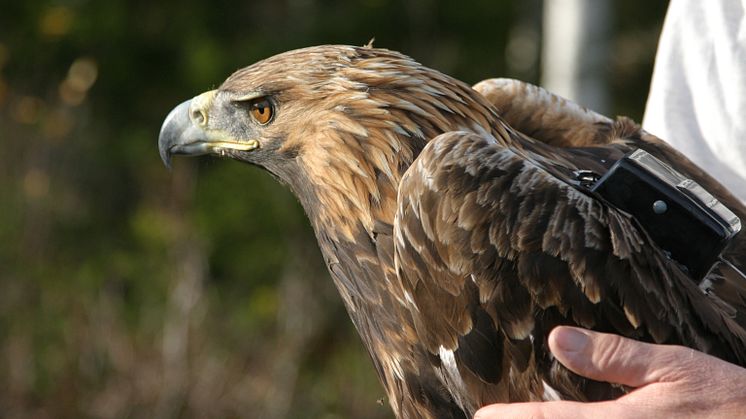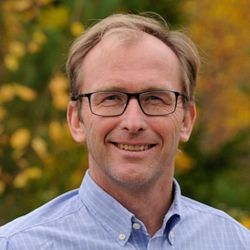
Pressmeddelande -
Golden eagles studied by satellite
Large-scale wind farm establishment may have a negative effect on Sweden’s golden eagles. In a unique project in northern Sweden, scientists at the Swedish University of Agricultural Sciences (SLU) are trapping adult golden eagles and fitting them with satellite transmitters.
The satellite transmitters emit a signal once an hour during the daytime. These signals provide the scientists with a picture of how the birds use the landscape.
“Hopefully we can identify the golden eagles’ favourite habitats. When we’ve done that we can see where wind farms can be established without disturbing the eagles,” says project manager Tim Hipkiss at SLU’s Department of Wildlife, Fish and Environmental Studies.
The potential risks with wind farms are that the birds collide with the rotor blades and lose valuable hunting habitat.
Up to now the scientists have fitted transmitters on to six eagles. The goal is twenty adult eagles from ten territories, five where wind farms are planned and five without wind farms (reference areas). The project is estimated to run for long enough for the scientists to monitor the eagles during wind farm establishment. Most of the sites are in Västerbotten county in northern Sweden.
“Trapping adult golden eagles alive has never been done before in Sweden, and probably nowhere else in Europe. This is unique, and most people thought we wouldn’t succeed,” says Tim Hipkiss.
SLU’s scientists have acquired the assistance of some of the world’s leading experts in this field, from USA, where it is more common to trap birds of prey as part of conservation projects.
The trapping is carried out by the scientists placing out carrion at feeding sites a few weeks in advance, so that the eagles get used to finding food there. After this the American experts conceal a net trap and erect a hide a small distance from the net.
“Then you just have to wait patiently in the hide. When the eagle lands on the food, the person in the hide releases the net. With the help of an assistant waiting nearby the eagle is then dealt with,” says Tim Hipkiss.
Fitting the satellite transmitter takes around half an hour, and it is important those involved know what they are doing. The eagles can weigh up to six kilos and wield dangerous claws. By weighing the bird and measuring its wing-length, you can tell if it is a male or a female (females are larger). The transmitter sits in place like a comfortable backpack.
Tim Hipkiss says that the birds have no problems flying with these transmitters. The adult birds fly several kilometres per day. Last summer, the scientists also fitted five juvenile golden eagles with transmitters, and have since monitored them for several months.
“The juveniles fly as they should, and some have already flown to new hunting grounds tens of kilometres away. Thanks to the transmitters we can find the birds if any of them have any problems, for example have not moved for several days,” says Tim Hipkiss.
The satellite transmitters will provide information on how far the eagles fly and how they move about their territories before and after wind farm establishment. The scientists have already observed that the eagles fly further than previously thought.
“It’s really great to see that this works. So far the project looks successful,” says Tim Hipkiss.
The project “Effects of wind farms on the habitat use and reproductive success of golden eagles” is financed by the Swedish Energy Agency (Vindval programme) and the power companies Vattenfall and Statkraft.
See earlier press release: http://www.slu.se/en/about-slu/fristaende-sidor-eng/whats-on/news/2010/7/transmitters-fitted-to-golden-eagles-show-effects-of-wind-power-exploitation/
Contact: Tim Hipkiss, +46 90 786 8685 or +46 70 578 2032, tim.hipkiss@vfm.slu.se
Photo Byline:
Adult golden eagle with a backpack-resembling satellite transmitter. The signals emitted from the satellite transmitter provides information on how the eagles fly and move about their territories. The golden eagle (Aquila chrysaetos) is classified as near threatened in Sweden. Photo: Jeff Kidd

